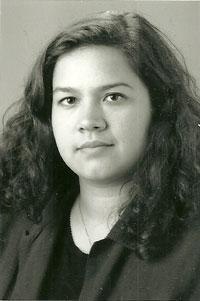
PhD, Embryology, Johns Hopkins University, 2008
University of California at Riverside
McNair Scholar, 1997
Major: Biology
Mentor: John Collins, Ph.D.
Research Topic: Mapping the mut-2 mutator gene in the model organism Caenorhabditis elegans
Mapping the mut-2 mutator gene in the model organism Caenorhabditis elegans
Transposable elements (or transposons) are small segments of DNA that are mobile within the genome and can cause spontaneous mutations, alterations in gene expression and reorganization of DNA. The focus of this study is to investigate the mechanisms that regulate transposon activity in eukaryotic genomes, looking specifically at the mut-2 gene in the nematode C. elegans.
Previous research has shown that mut-2 plays a central role in regulation of transposons in C. elegans, but the mechanism by which it represses transposition is unknown. By mapping and cloning mut-2, the function of the encoded gene product can be characterized. Standard recombination mapping is being used to localize mut-2. Prior results implementing this technique have placed mut-2 on chromosome I to the left and near the gene sem-4. The current mapping of mut-2 is being done with respect to dpy-14. dpy-14 is to the left of sem-4. If the results indicate that mut-2 maps to the right of dpy-14, then this will localize the gene to a region small enough to begin cloning efforts.
To map mut-2, it was first necessary to construct a strain with the appropriate genetic markers. A strain containing an unc-13 marker was isolated and crossed by a mut-2 sem-4 strain to create the desired mut-2 sem-4 unc-13 strain. This was crossed by a dpy-14 strain and recombinants will be isolated to map mut-2 with respect to dpy-14. A strain which shows the phenotypes dpy-14 and sem-4 unc-13, and has a high incidence of males (HIM) (> .05%) in a population supports the presence of mut-2 to the right of dpy-14.